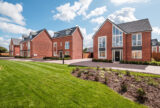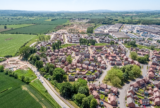Why Romans, a rebel king, and 400 nuns weren’t wrong about Wantage

New builds in old locations offer homebuyers who love period homes but hate whistling drafts the best of both worlds. Kingsgrove, the St. Modwen development at Wantage, nestled among the lushness of Oxfordshire’s countryside, has so much history archaeologists are basically the area’s fourth emergency service. Roman village, birthplace of Alfred the Great, legendary Saxon king, Cavalier stronghold during the English Civil War, and one time residence to 400 Anglican nuns. Communities have always seen something in this place worth calling home – and constant evolution has kept that spark alive.
“We wanted someone to produce quality homes and also create something valuable to the community for generations,” Harford Smith says of his decision to sell the land owned and farmed by his family for 150 years for development, on which Kingsgrove is being built, and fulfil a legacy hoped for by his late father. Windows, aptly a Roman invention, in the 500 current homes – which will eventually become 1500 – at Kingsgrove are an example of this sensitivity. “The windows in the St. Modwen homes are much bigger, to let more light in, because light affects people’s attitudes,” says Smith, who was born and raised on the estate farm, “St. Modwen thought about those things, which makes a difference”.
Weaved into the greenfield site are other human-first features; a neighbourhood of allotments, an orchard, and sport and recreation areas. Restaurants and local shops will also join as the multi-year development grows. “We wanted to develop a community, not just a dormitory,” says Smith, “I believe it is working extremely well”.

To make it work, Kingsgrove is built to attract different generations; near the soon-to-be-built care home the new primary school has just welcomed its second intake, among them forensic scientist Claire Heron’s six-year-old daughter. The Herons moved to Kingsgrove in November 2020 from a pastoral idyll not too far away seeking a bit more life. “Some estates are just concrete jungles, here we’ve got the best of both worlds,” she says, “the rural village life which we love, with the diversity and amenities of a town”.
Kingsgrove has 100 acres of green space and newly planted woodland. Wantage, with its hive-like Wednesday and Saturday markets, is walking distance. Car congestion in the village will be cut as part of the St. Modwen deal, while keeping residents connected. There’s also funding for a new relief road west towards Swindon, and east to the A34, the main artery between Oxford and the South. Heron’s husband, a planning officer himself, went over the development with ultra-scrutiny before they moved. “He looked into it and knew it had been well thought out, which was important because we want to be part of a new community,” she says.
Networks are notoriously tricky to manifest in new communities. St. Modwen is cultivating at least four exchanges of residents, estate management, developers, landowners, and councillors. District council community development officer Sophie Milton, and Andrea Clarke, residential portfolio manager for St. Modwen, are gently simmering a glue of social cohesion. “I say to residents ‘look, we really need people we can communicate with as the development grows’”, says Clarke, “then we start consulting them on getting a local bakery in the public square, and how they need the sports pitches managed, really delve into what they want”.

Unusually, Milton’s role is paid for by St. Modwen. Alongside corralling Facebook groups and plans for next year’s Platinum Jubilee, Milton goes door knocking. “It’s the sort of informal interaction where you get to the root of things,” she says, like how the playground under construction will cater for local children with disabilities.
She sees her role as a catalyst for what, with a little nudge, can grow organically at Kingsgrove; in a recent survey St. Modwen found 96% of residents wanted to get to know their neighbours. “I make those early connections”, she says, “but really it’s about linking residents to tap into their neighbourhood, to feel the two most important things” – why Romans to nuns have built lives in this area for 2000 years – “safe and happy in their community”.



